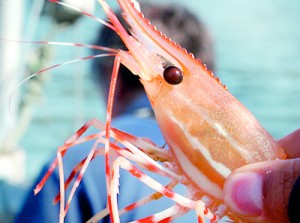Sunday Times 2
Prawns on Prozac
Tiny quantities of anti-depressants flushed down our sinks and toilets are having a dramatic effect on the behaviour and biology of crustaceans.
Scientists are becoming increasingly aware that common drugs including Prozac and Sertraline are ending up in our seas and rivers via human waste treatment plants.

Researchers claim aquatic wildlife, such as the spot prawn pictured, can be affected by exceedingly small amounts - as little as one nanogramme per litre - of prescription drugs. The research found even low concentrations of these drugs can cause creatures to change colour, grow larger or spawn more regularly (CC BY-ND 2.0 'Spot Prawn' by theforeignflash)
The research found even low concentrations of these drugs are causing the creatures to change colour, grow larger or spawn more regularly.
And in some cases, a lower concentration affected the creatures more than a higher dose.
‘There is a staggering list of prescription drugs passed from humans to wastewater treatment plants and into receiving streams, estuaries, or oceans by direct consumption, metabolism, and excretion, or by toilet flushing of old prescriptions,’ said Dr Alex Ford, a marine biologist from the University of Portsmouth.
‘Marine invertebrates, such as amphipod shrimp become more active and increase their speed of movement, while freshwater snails display altered reproduction, and some lose their ability to attach to surfaces. ‘Some bivalve species, such as zebra mussels, were induced to spawn when exposed to anti-depressants.
Dr Ford added that just as antidepressants affect hormones such as serotonin in the human brain, many biological functions within invertebrates are similarly under the control of serotonin.
‘In many invertebrates, serotonin controls the release of certain pigments, causing the creature to change colour and recent studies have shown that anti-depressants can alter colour changes in cuttlefish. The drugs can also affect growth, feeding and metabolism,’ he said. ‘What we now know is they can be affected by exceedingly small amounts, as little as one nanogram per litre – the equivalent of dropping a few grains of the compound into an Olympic-sized swimming pool.
‘Although concentrations observed in our rivers and estuaries are very small, it’s worrying that an increasing number of studies have shown that these incredibly small concentrations can dramatically alter the biology of the organisms they come in contact with.’
Dr Ford said the release of human pharmaceuticals into aquatic ecosystems is an environmental problem we should consider seriously.
‘A body of evidence is building that suggests anti-depressants at concentrations currently found in surface, waste and groundwater are sufficient to cause a wide variety of effects.
‘This is despite the fact that reports indicate these types of drugs take up only 4 per cent of the known pharmaceuticals detected in the environment.’
The research is published in the journal Aquatic Toxicology.
© Daily Mail, London


